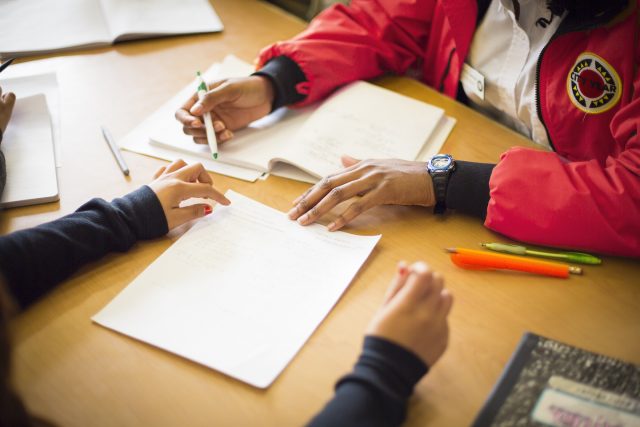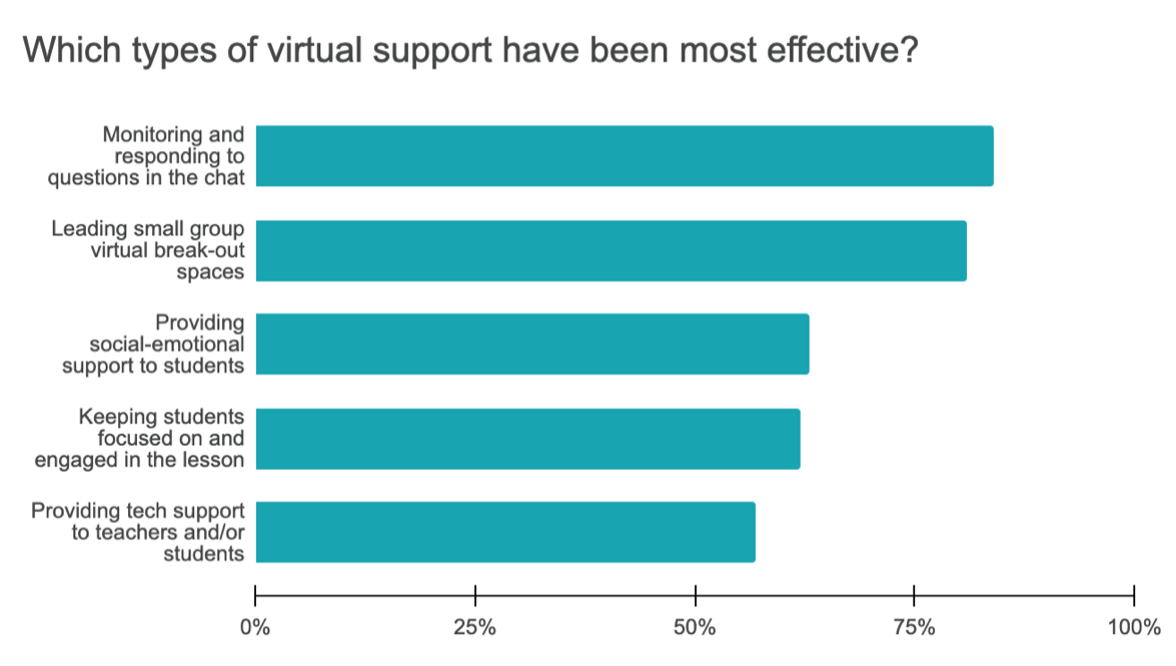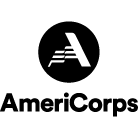What the COVID-19 pandemic taught us about supporting students and practitioners
The pandemic has ushered in unprecedented trials that touch every aspect of our lives, including school closures that upended the nature of schooling and instruction in ways that continue to affect students, families, schools and teachers across the country. Education practitioners, including teachers and City Year AmeriCorps members who serve as student success coaches, mentoring and tutoring students in systemically under-resourced public schools across 29 U.S. cities, have adjusted their approaches to meet students’ expanded needs during this time.
Two studies conducted during the pandemic shed light on how City Year adapted its services in response to the pandemic; share how City Year leveraged research to learn about the experiences of students and practitioners during COVID-19; and provide recommendations for practice based on these findings.

City Year’s holistic approach
AmeriCorps members are trained in City Year’s Whole School, Whole Child™ services that are designed to foster social, emotional and academic skills that prepare students for success in school, postsecondary education and the workforce. Since March 2020, AmeriCorps members have provided in-person, virtual and hybrid services based on local context and needs. The chart below highlights AmeriCorps member practices that partner teachers identified as most effective in the 2020-2021 City Year Service Partner Survey.

Throughout the pandemic, City Year supported AmeriCorps members, teachers, administrators and families in advancing student success and well-being by providing training, resources and tools. For example, to support practitioners during the pandemic and beyond, City Year has created guides (called seasonal change packages because they are released in the fall, winter and spring) to provide educators with timely and practical ideas to support student engagement and belonging.
City Year also partnered with Johns Hopkins to create an Action Community, a collaboration network for school partners to share experiences, strategies and best practices and brainstorm new ways to support students during the pandemic.
Measuring impact and improvement during COVID-19
In March 2020, two ongoing research projects were recalibrated to foreground the experiences of students and practitioners and capture City Year’s efforts to continue to support students, AmeriCorps members and school partners during a global pandemic.
The first study, How a Personalized Approach to Learning Helped One Organization Quickly Adapt in a Global Pandemic: A City Year Case Study (March 2021) by Jacquie Beaubien of Motivation, Mindset and Equity Consulting, brings to life insights on the practices and conditions that allowed AmeriCorps members to continue to personalize learning for students as they transitioned to distance learning in the spring and summer of 2020. Explore the case study’s highlights in this brief overview.
A second report, Challenges and Opportunities: Student and Practitioner Experiences During COVID-19 (June 2021) by Jade Eckels, City Year Manager of Education Research and Strategy, captures the experiences of students and practitioners regarding attendance; social, emotional and academic development (SEAD); and equity during the pandemic and highlights emerging effective practices. Explore the report’s highlights.
Together, these two studies elevate the voices of students and those closest to the work–AmeriCorps members and classroom teachers – to bring to life their extraordinary efforts to support student success and respond to new and evolving conditions. They draw insights from City Year’s work across the country and highlight how several City Year sites and Compass Academy adjusted their practices to respond to the unique challenges that students are facing in the wake of COVID-19-induced school closures. adjusted their practices to respond to the unique challenges that students are facing in the wake of COVID-19-induced school closures.
Key findings:
An increased focus on equity and social-emotional development ensured inclusive human-centered practices and approaches.
- Social-emotional well-being should be a factor when assessing a student’s readiness to learn and integration of academics and social-emotional development should be central to any efforts to reimagine schooling.
- Leaning into building strong developmental relationships proved critical for maintaining students’ trust and engagement.
- Modeling a personalized approach to learning and development at all levels of the organization allowed for enhanced nimbleness and innovation.
- AmeriCorps members were invaluable partners to teachers in classrooms as they worked together to meet students’ shifting needs, showing the value of strategically integrated, well-trained additional capacity.
- Prioritizing trust and strong relationships at every level of an organization is the foundation for creating inclusive, personalized conditions for effective student and organizational learning.
- COVID-19 enabled practitioners to innovate on pedagogical practices, class material, service delivery and more, yielding many new effective practices that can be leveraged post-pandemic.
Recommendations for practice
Below are recommendations to aid practitioners in their efforts to support students and communities as they recover from the impact of COVID-19. Each of these practices has its roots in strong relationships among students, practitioners and community members.
Social, Emotional and Academic Development (SEAD)
The need to prioritize SEAD is essential for all, but especially for the students and communities hardest hit by the tragedies associated with the pandemic such as the death of family members, homelessness, food insecurity, job loss, lack of access to healthcare, lack of transportation and other hardships. Nationally, the combination of witnessing the disproportionate impact of the pandemic on communities of color and the murder of George Floyd caused a racial reckoning and surge of desire to confront the pervasive historical and present-day structural barriers faced by people who are marginalized.
Creating the conditions in which healing and recovery can happen is not possible without creating the conditions that center relationships and prioritize SEAD. Both reports provide key practices that practitioners can leverage to integrate academics and social-emotional development more effectively in the classroom.
1. Assertiveness: Present students with choices to give them autonomy and agency.
a) A student survey piloted at a City Year site on the West Coast this year shows that 77% of students say that their AmeriCorps member considers their ideas when making decisions.
2. Trust & Belonging: Help students feel that the learning environment is a safe space to bring their full selves.
a) Given the disruption to students’ social systems of support, AmeriCorps members have worked hard to build relationships with and among students virtually. AmeriCorps members leveraged social media and technology in creative ways and engaged with students holistically, taking the time to learn about their personal lives and interests. AmeriCorps members sought to build community among students by creating virtual games and activities that allowed students to get to know each other, discover shared interests, and make connections.
b) COVID-19 has allowed for even deeper collaboration among AmeriCorps members and teachers as they work together to meet student needs. Practitioners cited trust and strong relationships as the foundation for creating productive partnerships between AmeriCorps members and teachers, personalizing learning for students, and bolstering student engagement in the virtual space.
c) Key elements of building strong, trusting “developmental” relationships between practitioners and with students included: expressing care and warmth; persistence and dependability; transparency; vulnerability and emotional safety; and sharing power.
3. Active engagement: Incorporating physical connection and engagement with the world into lessons can make them more engaging and relevant for students.
a) Distractions in students’ home environments, screen time fatigue, lack of social interaction, and disparities in access to technology have all contributed to widespread difficulties with student engagement during the pandemic. Practitioners have found that getting creative with technology and finding workarounds (e.g., virtual field trips) make instruction more engaging and effective for students.
4. Growth mindset: Support students in developing a growth mindset by avoiding person praise, asking students to explain their thinking, ensuring productive reflection on mistakes, helping them see and celebrate their progress, and helping them reflect on what led to success or what is getting in the way of their success if they are struggling.
a) Student survey results show that 64% of students feel that their AmeriCorps member says it is more important to try in class than to get things right the first time, and 76% percent of students feel that their AmeriCorps member explains things in a different way if they don’t understand it the first time.
b) AmeriCorps members encourage students to use the Chat feature on Zoom to reach out to their AmeriCorps member or teacher. Students can share understanding in the chat on a scale of 1-5 (1 is completely lost and 5 is expert level). AmeriCorps members monitor the chat during a live virtual session, helping to prevent students from falling behind.
c) Additionally, some of the most effective instructional tools for AmeriCorps members are platforms like DESMOS and Pear Deck. Teachers and AmeriCorps members can see students’ answers, and there are interactive features like polls and a slide bar where students can indicate how confident they feel about a concept. These tools allow practitioners to monitor student progress during a lesson even when students are not engaging in the chat and/or have their cameras off.
5. High standards and reassurance: Hold students to high standards and provide reassurance that you believe they can reach those standards.
6. Addressing trauma and supporting resilience: In a virtual setting, leverage technology and software (online polling, for example) to get pulse checks from students and hear how they are feeling at a particular moment in time.
a) Adjusting to being a student and being present for school while navigating their home lives has been difficult for students. AmeriCorps members have been cognizant of what students may be going through at home and prioritize their needs. Compass Academy has discovered that home visits are an effective intervention and has completed more than twice as many home visits compared to prior years.
Innovations that practitioners want to continue
The following are innovations that build on the strong foundation provided by approaches that are grounded in developmental relationships and focus on SEAD.
1. Integrate technology.
Practitioners increased their use of technology in response to virtual schooling and found that for many students, these new approaches to learning increased engagement and the ability to personalize learning. Practitioners want to continue to build their computer literacy skills once they return to in-person instruction. Education technology tools such as Class Dojo, the Zoom polling feature and Kahoot enhanced AmeriCorps members’ ability to support distance learning, improving engagement and attendance. Practitioners should address technology skill gaps and collaborate with education technology organizations to further personalize learning for students.
2. Increase engagement with families.
Practitioners felt that the transition to virtual learning resulted in increased connections between families and practitioners, compared to past years. Interactions between practitioners and families during the pandemic were also more positive and less focused on problems. It’s important to maintain the increased family engagement that occurred during COVID-19 to better serve students and their families. A recommended practice is making phone calls and engaging social media to connect with families and students.
3. Enhance enrichment programs, including afterschool programs, and deepen partnerships.
Practitioners want to expand afterschool programming to include extracurricular activities in addition to academic supports. Practitioners have also formed connections and partnerships with afterschool providers that they wish to maintain post-pandemic. Practitioners should continue to leverage support from partner organizations to streamline services and align their work with partners to effectively support student success. These enrichment opportunities help to expand educational equity and foster both students’ sense of belonging and agency.
4. Leverage critical additional capacity provided by student success coaches.
Practitioners want to continue to integrate AmeriCorps members more into the classroom as student success coaches. AmeriCorps members helped with technology, administrative and management tasks in the classroom (like admitting students, taking attendance, connecting students to the online platforms, managing the chat function in Zoom, etc.).
Ninety-four percent of partner principals agree that City Year has supported their schools’ transitions between in person and distance or hybrid learning, and 95% of partner principals and partner teachers say AmeriCorps members have supported student engagement and participation in school during the pandemic.
Distance learning has made the value of AmeriCorps members undeniable. They have a vital role to play in recovery efforts post-COVID and in advancing educational equity.
Conclusion
As an education and youth development organization that delivers direct services to students, schools and communities, City Year grounds our approach in both practice and research. We actively work to internalize what we are learning; continuously learn and improve; and share our innovations and struggles with the wider education sphere. To support the dissemination of our insights more broadly, we have started to create companion guides for practitioners and policymakers.
Through the practitioner guides, including What City Year is learning about the power of integrating social, emotional and academic development in public schools A GUIDE FOR PRACTITIONERS AND POLICYMAKERS and Leaning into personalization to support students and adults during COVID-19, we aim to show that research can and should be inextricably connected to practice, and vice versa.
This essay is part of an ongoing series by members of the Education Research & Strategy team at City Year Headquarters.
Related stories
Yes, the holiday season can be stressful—making travel plans, wrapping up work before winter break, figuring out what gifts to...
Read more about Three reasons students may be thankful for their student success coachEvery year, thousands of young people decide to join AmeriCorps programs for a year (or more!) of service, helping to...
Read more about Everything you need to know about returning for another year as a City Year AmeriCorps memberCity Year is committed to providing our AmeriCorps members with resources, opportunities and support that help them to achieve their...
Read more about Empowering Futures: City Year Baton Rouge’s Partnership with Bottom LineFatimah Abdulmateen takes service seriously. Fatimah served two years with City Year as an AmeriCorps member, making her an alum...
Read more about A City Year alum with a passion for service—both here and abroad















